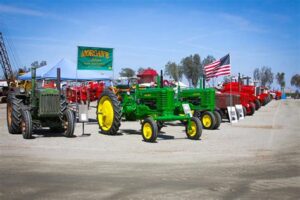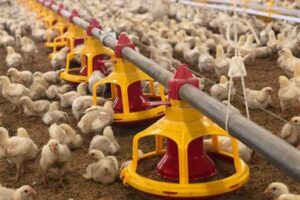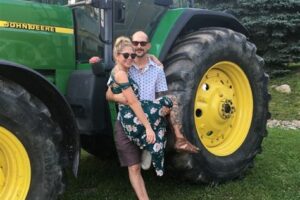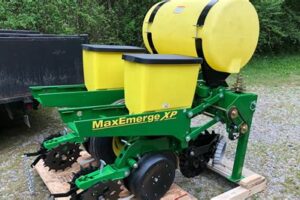Table of Contents
Looking for small farm hay equipment? Find a wide range of high-quality hay equipment specially designed for small farms. From hay balers and rakes to tedders and mowers, discover the perfect tools to efficiently harvest and manage your hay crops. Improve your productivity and maximize your yield with reliable small farm hay equipment.
When it comes to running a small farm, having the right equipment is crucial for efficiency and productivity. One area that often requires specialized tools is hay production. Whether you have a few acres or a larger operation, investing in small farm hay equipment can make all the difference in the quality and quantity of your hay yield. From mowers and tedders to rakes and balers, these essential machines can help streamline the process of harvesting and baling hay. With advancements in technology, there are now a wide range of options available, making it easier than ever for small farm owners to find the perfect equipment to suit their needs. In this article, we will explore the advantages of using small farm hay equipment and discuss some popular options that can help take your hay production to the next level.
Introduction
Small farmers play a crucial role in feeding communities and supporting local economies. However, managing a small farm can be a challenging task, especially when it comes to hay production. Fortunately, there is a range of specialized equipment available that can simplify the process and increase efficiency. In this article, we will explore the various types of small farm hay equipment and their benefits.
Baling Equipment
1. Small Square Balers
Small square balers are ideal for small farms due to their compact size and versatility. They efficiently compress hay into compact, square-shaped bales that are easy to handle and store. These balers are typically powered by tractors and can produce bales of varying sizes to suit different needs.
2. Round Balers
Round balers are another popular option for small farms. They create cylindrical bales, which are larger and heavier than square bales. Round balers are highly efficient and can handle large volumes of hay quickly. They are often equipped with features such as automatic tying systems, which further streamline the baling process.
Cutting Equipment
3. Mowers
Mowers are essential for cutting hay before it is baled. There are various types of mowers available, including disc mowers and sickle bar mowers. Disc mowers are known for their speed and efficiency, while sickle bar mowers are better suited for uneven terrain. Choosing the right mower depends on factors such as farm size, terrain, and personal preference.
4. Tedders
Tedders are used to spread and aerate cut hay, helping it dry quickly and evenly. These machines feature rotating forks that gently lift and turn the hay, ensuring optimal drying conditions. Tedding reduces the risk of mold and spoilage, resulting in higher-quality hay.
Raking Equipment
5. Wheel Rakes
Wheel rakes are commonly used in small farms due to their simplicity and affordability. These rakes use rotating wheels with tines to gather hay into windrows, making it easier for baling or further processing. They can be adjusted to create windrows of different sizes, allowing farmers to adapt to varying field conditions.
6. Rotary Rakes
Rotary rakes are highly efficient and suitable for larger operations. They feature spinning wheels or rotors with tines that sweep the hay into uniform windrows. Rotary rakes are known for their speed and ability to handle heavy crops. However, they may be more expensive than wheel rakes.
Handling Equipment
7. Hay Loaders
Hay loaders, also known as stackers or accumulators, are designed to pick up bales and stack them neatly. These machines save time and physical labor by automating the process of moving and stacking hay. Hay loaders come in various sizes, with some models capable of handling multiple bales simultaneously.
8. Bale Wrappers
Bale wrappers are essential for small farms that produce hay for livestock feed. They tightly wrap bales in protective plastic film, preserving the nutritional value of the hay and preventing spoilage. Bale wrappers can be operated manually or via a tractor’s power take-off (PTO) system.
Conclusion
Investing in small farm hay equipment can greatly enhance the efficiency and productivity of your operation. With the right combination of baling, cutting, raking, and handling equipment, you can streamline the hay production process and ensure high-quality feed for your animals. Take the time to assess your farm’s specific needs and choose equipment that best suits your requirements. By doing so, you can maximize your small farm’s potential and contribute to the success of your local agricultural community.
Introducing Small Farm Hay Equipment
Small farm hay equipment is gear specially designed to optimize the production and management of hay on small-scale farms. This essential machinery facilitates various tasks such as cutting, drying, tedding, raking, and baling hay. With small farm hay equipment, farmers can streamline their operations, saving both time and effort.
Why Investing in Small Farm Hay Equipment is Crucial
Investing in small farm hay equipment is vital for small-scale farmers aiming to optimize their productivity and cost-effectiveness. With the right machinery, farmers can efficiently process hay, ensuring high-quality forage for their livestock or commercial sale. This equipment not only minimizes manual labor but also enables farmers to meet deadlines and maximize their crop yield.
Choosing the Right Small Farm Hay Equipment
Selecting the suitable small farm hay equipment requires careful consideration of individual farm needs and available resources. Key factors to consider are the farm size, the type of hay being produced, the intended usage frequency, and the available budget. Optimal choices may include compact hay balers, rotary rakes, disc mowers, and tedders, depending on specific requirements.
Benefits of Compact Hay Balers
Compact hay balers are essential for small farms as they efficiently compress cut hay into compact bales, making it easier to handle, store, and transport. These balers are specifically designed to align with the scale of small farm operations and often come with features such as adjustable bale sizes and user-friendly controls, enhancing convenience and minimizing wastage.
Enhancing Efficiency with Rotary Rakes
Rotary rakes play a fundamental role in the hay-making process, effectively gathering cut hay into windrows for drying or baling. Small-scale farmers benefit from compact and maneuverable rotary rakes, which allow them to operate seamlessly in small field spaces or irregularly shaped areas. These rakes are designed for precision and minimize crop loss during gathering, ultimately increasing overall efficiency.
The Importance of Disc Mowers
Disc mowers are essential components of small farm hay equipment, as they enable quick and precise hay cutting. These machines consist of multiple cutting discs equipped with sharp, durable blades that ensure clean and consistent cutting across various field conditions. Small-scale farmers can benefit from disc mowers that can be easily attached to lightweight tractors, making them suitable for diverse farm sizes and terrain.
Significance of Tedders in Hay Drying
Tedders are pivotal equipment for small farm hay operations when it comes to drying freshly cut hay efficiently. These machines gently lift the cut hay, allowing it to aerate and dry evenly. Small-scale farmers can benefit from compact tedders that can navigate tight spaces and uneven ground, enabling them to expedite the drying process and protect the hay from spoilage caused by excessive moisture.
Maintenance and Safety Considerations
Proper maintenance and safety protocols are vital for small farm hay equipment. Regular cleaning, lubrication, and inspection of machinery components are necessary to ensure optimal performance and longevity. Additionally, operators should receive thorough training on safe operation and adhere to all safety guidelines to minimize accidents and protect both personnel and equipment.
Small farm hay equipment is an essential tool for farmers looking to efficiently manage their hay production. With the right equipment, farmers can streamline the process of cutting, drying, and baling hay, ultimately saving time and labor costs. Here are some key points highlighting the importance and benefits of using small farm hay equipment:
Increased productivity: Small farm hay equipment allows farmers to complete hay-related tasks much more quickly and efficiently compared to manual labor. With the ability to cut, rake, and bale hay in a single pass, farmers can significantly increase their productivity levels, saving valuable time and energy.
Improved hay quality: Using specialized hay equipment ensures that the hay is harvested at the optimal time and is handled in a way that preserves its nutritional value. Modern hay equipment is designed to minimize leaf loss, prevent mold growth, and maintain hay quality during the baling process, resulting in higher-quality feed for livestock.
Reduced labor costs: Investing in small farm hay equipment can help reduce labor costs associated with manual hay production. By replacing manual labor with efficient machinery, farmers can allocate their workforce to other farm tasks, increasing overall productivity and potentially reducing the need for additional labor.
Enhanced safety: Small farm hay equipment is equipped with various safety features designed to protect operators and minimize the risk of accidents. These features include shields, guards, and emergency stop buttons, ensuring that the equipment is operated safely and reducing the likelihood of injuries.
Cost-effective: Although small farm hay equipment requires an initial investment, it can be a cost-effective solution in the long run. By increasing productivity, improving hay quality, and reducing labor costs, farmers can ultimately save money and maximize their return on investment.
Time savings: The use of small farm hay equipment significantly reduces the time required to complete hay-related tasks. Farmers can efficiently cut, rake, and bale hay in a fraction of the time it would take manually, allowing them to focus on other essential farm operations or allocate more time to relax and enjoy their personal lives.
In conclusion, small farm hay equipment is a valuable asset for farmers looking to optimize their hay production. It offers increased productivity, improved hay quality, reduced labor costs, enhanced safety features, cost-effectiveness, and significant time savings. By investing in quality hay equipment, farmers can streamline their operations and achieve greater efficiency in their overall farming practices.
Thank you for taking the time to visit our blog and learn more about small farm hay equipment. We understand that as a small farmer, finding the right equipment for your operation is crucial to the success and efficiency of your business. In this article, we have provided valuable insights and information about the different types of hay equipment available, their benefits, and how they can enhance your farming practices.
We hope that through this article, you have gained a better understanding of the various options available to you when it comes to small farm hay equipment. From hay balers and rakes to tedders and mowers, each piece of equipment plays a vital role in the haymaking process. By investing in the right equipment, you can significantly improve your productivity and reduce labor costs, ultimately maximizing your profits.
As a professional in the industry, we highly recommend that you carefully consider your specific needs and requirements before purchasing any small farm hay equipment. Assess the size of your operation, the amount of hay you produce, and the terrain of your land. This will help you determine the appropriate size and type of equipment that will best suit your needs.
In conclusion, small farm hay equipment is an essential investment for any small farmer looking to streamline their haymaking process. By choosing the right equipment, you can save time, increase productivity, and ultimately improve the overall efficiency of your farm. We hope that the information provided in this article has been helpful in guiding you towards making informed decisions when it comes to purchasing small farm hay equipment. Thank you once again for visiting our blog, and we wish you all the best in your farming endeavors!
Video Small Farm Hay Equipment
People also ask about Small Farm Hay Equipment:
What types of small farm hay equipment are available?
There are several types of small farm hay equipment that you can choose from, depending on your specific needs. Some common types include hay rakes, hay tedders, hay balers, and hay bale wrappers.
What is the purpose of a hay rake?
A hay rake is used to gather and arrange cut hay into rows or windrows. It helps in the drying process by turning the hay to expose it evenly to the sun and air. This makes it easier to bale or stack the hay later.
What does a hay tedder do?
A hay tedder is designed to spread and fluff up the hay after it has been cut and raked. It helps to speed up the drying process by increasing the exposure of the hay to sunlight and air, reducing the time required for hay to dry before baling.
What are the different types of hay balers?
There are two main types of hay balers commonly used on small farms: round balers and square balers. Round balers create large cylindrical bales, while square balers produce rectangular bales. The choice between them depends on factors such as bale size preference and handling capabilities.
What is a hay bale wrapper used for?
A hay bale wrapper is used to preserve the quality of hay by wrapping it tightly in plastic film. This process creates an airtight seal around the bale, protecting it from moisture, mold, and other environmental factors. It is especially useful for preserving hay for extended periods or when storage facilities are limited.
What factors should I consider when choosing small farm hay equipment?
When selecting small farm hay equipment, it’s important to consider factors such as the size of your operation, available budget, desired bale size, and the specific needs of your hay production. You should also consider the ease of use, maintenance requirements, and the availability of local support and spare parts.






